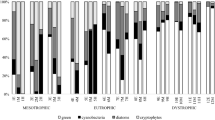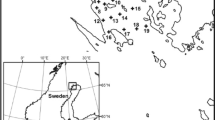Abstract
The pulsing of river discharge affects biodiversity and productivity of whole river–floodplain ecosystems, triggering the transport, storage and processing of carbon. In this study we investigate the short-term changes in water chemistry and net pelagic metabolism (NEP) in two floodplain lakes in response to a flood pulse. The two oxbow lakes investigated in the floodplain of the Mediterranean Ebro River (NE Spain) showed a clear temporal shift in their metabolic balance, controlled by the river discharge and associated changes in water physical and chemical characteristics. Water chemistry (turbidity, water organic matter, chlorophyll a and nutrients concentration) returned to pre-flood values after 4 days, highlighting the resilience of the ecosystem to flood pulses. Lake NEP was depressed before and during floods to a minimum of −34 mg O2 m−3 h−1, and increased after the flood pulse to a maximum of +463 mg O2 m−3 h−1. The phytoplankton assemblage showed before and after floods a replacement of autotrophic species (e.g. Chlorophyceans) by mixotrophic organisms (e.g. Cryptophyceans, Euglenoids). A linear mixed effects model identified abiotic factors, particularly temperature and river discharge, as significant predictors of the net aquatic metabolism and community respiration during flood conditions. Our results suggest that the role of the Ebro floodplain lakes as sources or sinks of C is complex and relative to the time scale investigated, depending strongly on the river discharge dynamics and the transport of limiting nutrients (phosphorus).




Similar content being viewed by others
References
Acuña, V., A. Giorgi, I. Munoz, U. Uehlinger & S. Sabater, 2004. Flow extremes and benthic organic matter shape the metabolism of a headwater Mediterranean stream. Freshwater Biology 49: 960–971.
Ahearn, D. S., J. H. Viers, J. F. Mount & R. A. Dahlgren, 2006. Priming the productivity pump: flood pulse driven trends in suspended algal biomass distribution across a restored floodplain. Freshwater Biology 51: 1417–1433.
Amoros, C. & G. Bornette, 2002. Connectivity and biocomplexity in waterbodies of riverine floodplains. Freshwater Biology 47: 761–776.
APHA, 1989. Standard Methods for the Examination of Water and Wastewater. APHA, Washington: 1715 pp.
Battin, T. J., L. A. Kaplan, S. Findlay, C. S. Hopkinson, E. Marti, A. I. Packman, J. D. Newbold & F. Sabater, 2008. Biophysical controls on organic carbon fluxes in fluvial networks. Nature Geoscience 1: 95–100.
Biddanda, B. A. & J. B. Cotner, 2002. Love handles in aquatic ecosystems: The role of dissolved organic carbon drawdown, resuspended sediments, and terrigenous inputs in the carbon balance of Lake Michigan. Ecosystems 5: 431–445.
Bonada, N., S. Doledec & B. Statzner, 2007. Taxonomic and biological trait differences of stream macroinvertebrate communities between mediterranean and temperate regions: implications for future climatic scenarios. Global Change Biology 13: 1658–1671.
Burford, M. A., A. J. Cook, C. S. Fellows, S. R. Balcombe & S. E. Bunn, 2008. Sources of carbon fuelling production in an arid floodplain river. Marine and Freshwater Research 59: 224–234.
Cabezas, A., E. González, B. Gallardo, M. García, M. González & F. A. Comín, 2008. Effects of hydrological connectivity on the substrate and understory structure of riparian wetlands in the Middle Ebro River (NE Spain): implications for restoration and management. Aquatic Sciences 70: 361–376.
Cabezas, A., F. A. Comin & D. E. Walling, 2009a. Changing patterns of organic carbon and nitrogen accretion on the middle Ebro floodplain (NE Spain). Ecological Engineering 35: 1547–1558.
Cabezas, A., M. Garcia, B. Gallardo, E. Gonzalez, M. Gonzalez-Sanchis & F. A. Comin, 2009b. The effect of anthropogenic disturbance on the hydrochemical characteristics of riparian wetlands at the Middle Ebro River (NE Spain). Hydrobiologia 617: 101–116.
Castillo, M. M., 2000. Influence of hydrological seasonality on bacterioplankton in two neotropical floodplain lakes. Hydrobiologia 437: 57–69.
Coloso, J., J. Cole & M. Pace, 2011. Difficulty in discerning drivers of lake ecosystem metabolism with high-frequency data. Ecosystems 14: 935–948.
Comín, F. A., V. Rosas & C. Ciancarelli, 2005. Assessment of water quality changes on floodplains of the Ebro River (NE Spain). Archiv Fur Hydrobiologie-Supplementbände 15: 187–197.
Cotner, J. B., J. V. Montoya, D. L. Roelke & K. O. Winemiller, 2006. Seasonally variable riverine production in the Venezuelan llanos. Journal of the North American Benthological Society 25: 171–184.
Crawley, M. J., 2007. The R Book. Wiley, Chichester: 942 pp.
Delgiorgio, P. A. & J. M. Gasol, 1995. Biomass distribution in freshwater plankton communities. American Naturalist 146: 135–152.
Delgiorgio, P. A. & R. H. Peters, 1994. Patterns in planktonic P-R ratios in lakes: influence of lake trophy and dissolved organic-carbon. Limnology and Oceanography 39: 772–787.
Duarte, C. M. & Y. T. Prairie, 2005. Prevalence of heterotrophy and atmospheric CO2 emissions from aquatic ecosystems. Ecosystems 8: 862–870.
Forsberg, B. R., A. H. Devol, J. E. Richey, L. A. Martinelli & H. Dossantos, 1988. Factors controlling nutrient concentrations in Amazon floodplain lakes. Limnology and Oceanography 33: 41–56.
Gallardo, B., M. García, A. Cabezas, E. González, M. González, C. Ciancarelli & F. A. Comín, 2008. Macroinvertebrate patterns along environmental gradients and hydrological connectivity within a regulated river–floodplain. Aquatic Sciences 70: 248–258.
Gallardo, B., M. González-Sanchís, A. Cabezas, S. Gascón & F. A. Comín, 2009. Modelling the response of floodplain aquatic communities across the lateral hydrological gradient. Marine and Freshwater Research 60: 924–935.
Gasith, A. & V. H. Resh, 1999. Streams in Mediterranean climate regions: abiotic influences and biotic responses to predictable seasonal events. Annual Review of Ecology and Systematics 30: 51–81.
Gonzalez, E., E. Muller, B. Gallardo, F. A. Comin & M. Gonzalez-Sanchis, 2010. Factors controlling litter production in a large Mediterranean river floodplain forest. Canadian Journal of Forest Research-Revue Canadienne De Recherche Forestiere 40: 1698–1709.
Hamilton, S. K. & W. M. Lewis, 1987. Causes of seasonality in the chemistry of a lake on the Orinoco river floodplain, Venezuela. Limnology and Oceanography 32: 1277–1290.
Hamilton, S. K., S. J. Sippel & J. M. Melack, 1995. Oxygen depletion and carbon-dioxide and methane production in waters of the Pantanal wetland of Brazil. Biogeochemistry 30: 115–141.
Hanson, P. C., D. L. Bade, S. R. Carpenter & T. K. Kratz, 2003. Lake metabolism: relationships with dissolved organic carbon and phosphorus. Limnology and Oceanography 48: 1112–1119.
Hanson, P. C., S. R. Carpenter, D. E. Armstrong, E. H. Stanley & T. K. Kratz, 2006. Lake dissolved inorganic carbon and dissolved oxygen: Changing drivers from days to decades. Ecological Monographs 76: 343–363.
Heiler, G., T. Hein, F. Schiemer & G. Bornette, 1995. Hydrological connectivity and flood pulses as the central aspects for the integrity of a river–floodplain system. Regulated Rivers-Research & Management 11: 351–361.
Hein, T., C. Baranyi, W. Reckendorfer & F. Schiemer, 2004. The impact of surface water exchange on the nutrient and particle dynamics in side-arms along the River Danube, Austria. Science of the Total Environment 328: 207–218.
Howarth, R. W., 1988. Nutrient limitation of net primary production in marine ecosystems. Annual Review of Ecology and Systematics 19: 89–110.
Junk, W. J., 1989. The use of Amazonian floodplains under an ecological perspective. Interciencia 14: 317–322.
Junk, W. J. & K. M. Wantzen, 2004. The flood pulse concept: new aspects, approaches, and applications. An update. In Welcomme, R. & T. Petr (eds), Proceedings of the 2nd Large River Symposium (LARS). Food and Agriculture Organization & Mekong River Commission, Pnom Penh: 117–149.
Junk, W. J., P. B. Bayley & R. E. Sparks, 1989. The flood pulse concept in river–floodplain systems. Canadian Special Publications of Fisheries and Aquatic Sciences 106: 110–127.
Keppel, G., 1991. Design and Analysis: A Researcher Handbook. Prentice Hall, Englewood Cliffs, NJ.
Larmola, T., J. Alm, S. Juutinen, S. Saarnio, P. J. Martikainen & J. Silvola, 2004. Floods can cause large interannual differences in littoral net ecosystem productivity. Limnology and Oceanography 49: 1896–1906.
Lopez-Archilla, A. I., S. Molla, M. C. Coleto, M. C. Guerrero & C. Montes, 2004. Ecosystem metabolism in a mediterranean shallow lake (Laguna de Santa Olalla, Donana National Park, SW Spain). Wetlands 24: 848–858.
Lucas, L. V., J. E. Cloern, J. K. Thompson & N. E. Monsen, 2002. Functional variability of habitats within the Sacramento-San Joaquin Delta: Restoration implications. Ecological Applications 12: 1528–1547.
Marcarelli, A. M., R. W. V. Kirk & C. V. Baxter, 2010. Predicting effects of hydrologic alteration and climate change on ecosystem metabolism in a western U.S. river. Ecological Applications 20: 2081–2088.
McGinness, H. M. & A. D. Arthur, 2011. Carbon dynamics during flood events in a lowland river: the importance of anabranches. Freshwater Biology 56: 1593–1605.
Mitsch, W. J. & J. G. Gosselink, 2000. The value of wetlands: importance of scale and landscape setting. Ecological Economics 35: 25–33.
Pamatmat, M. M., 1997. Non-photosynthetic oxygen production and non-respiratory oxygen uptake in the dark: a theory of oxygen dynamics in plankton communities. Marine Biology 129: 735–746.
Pinheiro, J., D. Bates, S. DebRoy, D. Sarkar & the R Development Core Team, 2012. nlme: Linear and Nonlinear Mixed Effects Models. R package version 3.1-103.
R Development Core Team, 2011. R: A Language and Environment for Statistical Computing. R Foundation for Statistical Computing, Vienna.
Schemel, L. E., T. R. Sommer, A. B. Muller-Solger & W. C. Harrell, 2004. Hydrologic variability, water chemistry, and phytoplankton biomass in a large floodplain of the Sacramento River, CA, USA. Hydrobiologia 513: 129–139.
Tockner, K. & J. A. Stanford, 2002. Riverine flood plains: present state and future trends. Environmental Conservation 29: 308–330.
Tockner, K., D. Pennetzdorfer, N. Reiner, F. Schiemer & J. V. Ward, 1999. Hydrological connectivity, and the exchange of organic matter and nutrients in a dynamic river–floodplain system (Danube, Austria). Freshwater Biology 41: 521–535.
Tuttle, C. L., L. Zhang & W. J. Mitsch, 2008. Aquatic metabolism as an indicator of the ecological effects of hydrologic pulsing in flow-through wetlands. Ecological Indicators 8: 795–806.
Uehlinger, U., 2000. Resistance and resilience of ecosystem metabolism in a flood-prone river system. Freshwater Biology 45: 319–332.
Uehlinger, U. & M. W. Naegeli, 1998. Ecosystem metabolism, disturbance, and stability in a prealpine gravel bed river. Journal of the North American Benthological Society 17: 165–178.
Valett, H. M., M. A. Baker, J. A. Morrice, C. S. Crawford, M. C. Molles, C. N. Dahm, D. L. Moyer, J. R. Thibault & L. M. Ellis, 2005. Biogeochemical and metabolic responses to the flood pulse in a semiarid floodplain. Ecology 86: 220–234.
Vandenbrink, F. W. B., J. P. H. M. Deleeuw, G. Vandervelde & G. M. Verheggen, 1993. Impact of hydrology on the chemistry and phytoplankton development in floodplain lakes along the lower Rhine and Meuse (vol 19, pg 103, 1992). Biogeochemistry 20: 213.
Vilches, C. & A. Giorgi, 2010. Metabolism in a macrophyte-rich stream exposed to flooding. Hydrobiologia 654: 57–65.
Vis, C., C. Hudon, R. Carignan & P. Gagnon, 2007. Spatial analysis of production by macrophytes, phytoplankton and epiphyton in a large river system under different water-level conditions. Ecosystems 10: 293–310.
Wantzen, K. M., W. J. Junk & K. O. Rothhaupt, 2008. An extension of the floodpulse concept (FPC) for lakes. Hydrobiologia 613: 151–170.
Ward, J. V., 1989. The 4-dimensional nature of lotic ecosystems. Journal of the North American Benthological Society 8: 2–8.
Wellborn, G. A., D. K. Skelly & E. E. Werner, 1996. Mechanisms creating community structure across a freshwater habitat gradient. Annual Review of Ecology and Systematics 27: 337–363.
Wetzel, R. G. & G. E. Likens, 1991. Limnological Analyses. Springer, New York: 391 pp.
Acknowledgments
This research was funded by the Spanish Ministry of Science and Innovation (MICINN CGL2008-05153-C02-01/BOS) and supported by Departments of the Environment and Science, Technology and University—Government of Aragon (Research Group E-61 on Ecological Restoration, and B061-2005 pre-doctoral grant). Thanks are also given to the Nature Reserve’s wardens (ANP-GA), as well as M. L. Dehesa, A. Cabezas, A. de Frutos and specially N. Zapata for their field assistance. I am also grateful to two anonymous reviewers and the handling editor Nick Bond whose comments on a previous version highly improved its quality.
Author information
Authors and Affiliations
Corresponding author
Additional information
Handling editor: Nicholas R. Bond
Rights and permissions
About this article
Cite this article
Gallardo, B., Español, C. & Comin, F.A. Aquatic metabolism short-term response to the flood pulse in a Mediterranean floodplain. Hydrobiologia 693, 251–264 (2012). https://doi.org/10.1007/s10750-012-1126-9
Received:
Revised:
Accepted:
Published:
Issue Date:
DOI: https://doi.org/10.1007/s10750-012-1126-9




